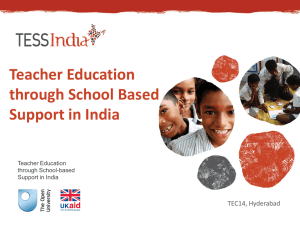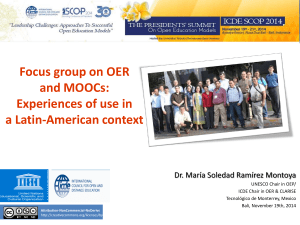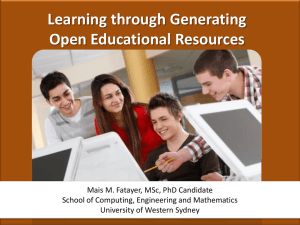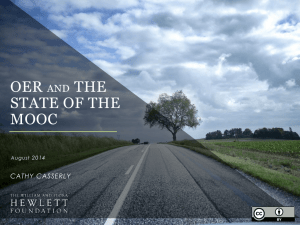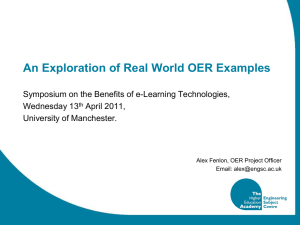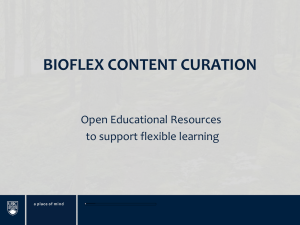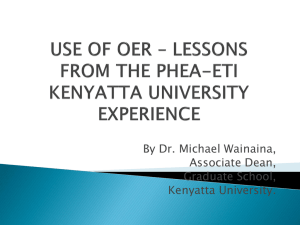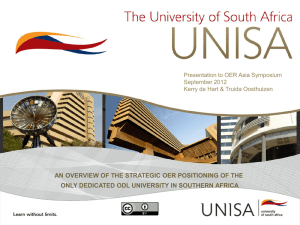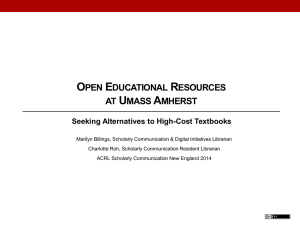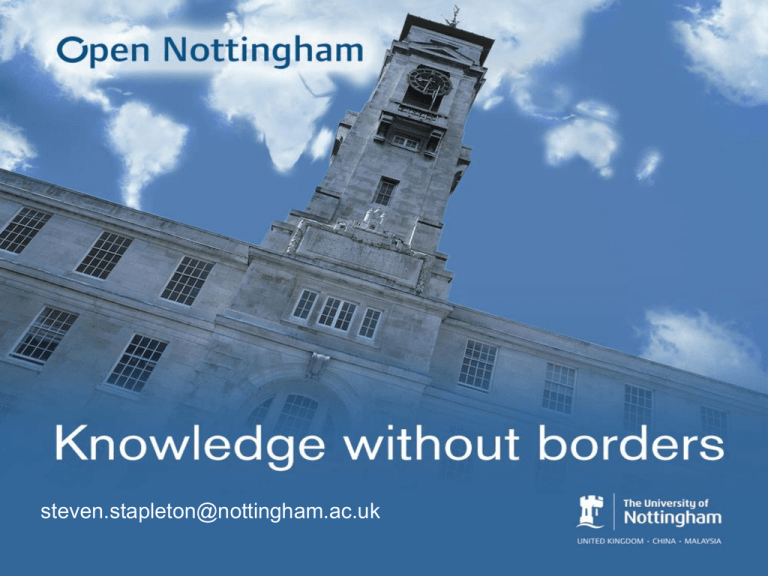
steven.stapleton@nottingham.ac.uk
Background – Understanding OERs
What are Open
Educational
Resources (OERs)?
Image © David Silver 2009
Released under creative commons
licence:
Source:
http://www.flickr.com/photos/66267550
@N00/3232753660
What are Open Educational
Resources?
1. Educational materials that are made freely available
over the internet
2. Available for use and adaptation under an open
(creative commons) license
3. Do not provide a qualification or access to
University staff
Pioneered by MIT in 2002
Make resources available from all courses
OpenCourseWare Consortium
Approximately 150 members
UK: Nottingham, Open University, Oxford (maths)
Background – Understanding OERs
The Internet as a
public place?
Image © Don Solo 2008
Released under creative
commons licence:
Source:
http://www.flickr.com/ph
otos/60648084@N00/24
62966749
What assumptions do
you make about
what is
appropriate?
Internet as a Public Place
Making material available on a publicly accessible web site
implies permission to perform activities necessary to view
it
Placing material on the internet does not imply the
granting of permission to adapt, distribute or copy the
work for other purposes
Misapprehension that the internet is somehow a gateway
to the 'Public Domain‘
Benefits
“A positive student experience depends on having
access to resources. Students and academics
will benefit from this move to make more
content available.”
David Sadler, Higher Education Academy Director of Networks
Quoted in JISC press release
Why is Nottingham involved?
Why is Nottingham involved?
Social responsibility
Excellence in education
Promotional opportunities
Internationalisation
Cost efficiencies (use and re-use)
Change Management
Social Responsibility
University 5 year Strategic Plan
Excellence in Education
Additional way of accessing learning / widening literature searches / planning
Promotional Opportunities
• Academic/Module/Course/School/University
• Can this be proved?
• New funding environment
On-line prospectuses, RSS feeds, links to e-staff profile,
school web pages
Internationalisation
Cost Efficiencies
• Save time
• Reduce costs
• Free up time to work on other activities
OER Initiatives and Investment
William and Flora Hewlett Foundation
UNESCO
OECD
OER Africa
HEA and JISC UKOER Programme
U-Now, UoN Podcasts, SONET, and ItunesU,
UoN Channel, Test Tube and Eduhub on
YouTube, XPERT and BERLiN projects at UoN
UoN module framework approach
Open Educational Resources (OERs)
Types and Examples
Full courses
Course/Module Handbooks
Lecture notes, presentations,
reading lists, syllabus, timetables
Tests and assignments
Themed course materials
Re-usable Learning Objects (RLOs)
Simulations
SONET
SimSHARE
Second Life and UoN
Audio, Videos, Images
Open Access journal articles
Textbooks
Licensing OERs
Licensing is an essential part of OER
process:
goes beyond making content ‘only’ viewable to
the public
It embodies the full ethos of “openness”
Alternative legal frameworks have been devised
by Legal Experts in area of new media
What are creative commons
licences?
“Creative Commons is a non-profit
organisation – founded 2001
making it easier for people to share their
own and build upon the work of others
free licenses and other legal tools to mark
creative work with the freedom the creator
wants it to carry
CC provides free, easy-to-use
legal tools (creativecommons.org)
“Their tools give everyone from individual
creators to large companies and
institutions a simple, standardised way to
grant copyright permissions to their
creative work.
The Creative Commons licenses enable
people to easily change their copyright
terms from the default of “all rights
reserved” to “some rights reserved.””
CC Licenses work alongside
copyright
“Creative Commons licenses are not an
alternative to copyright. They work
alongside copyright, so you can modify
your copyright terms to best suit your
needs.”
CC have a no rights reserved
option
“For those creators wishing to opt out of
the copyright altogether, Creative
Commons helps them do so by providing
tools that allow you to place your work as
squarely as possible within the public
domain — a “no rights reserved”
alternative to copyright.”
Exponential Growth
2001
Creative Commons founded.
2003
Approximately 1 million licenses in use.
2004
Estimated 4.7 million licensed works by the
end of the year.
2005
Estimated 20 million works.
Exponential Growth
2006
Estimated 50 million licensed works.
2007
Estimated 90 million licensed works.
2008
Estimated 130 million CC licensed works.
New Nine Inch Nails album released under
CC.
2009
Estimated 350 million CC licensed works.
Wikipedia migrates to CC AttributionShareAlike as its main content license
Creative Commons
Licence options
Attribution
ShareAlike
Non Commercial
Non-Derivative
Versions
Regionalised or
Unported
Six Licences
Attribution-Non-CommercialShare Alike 2.0 UK:England and
Wales (BY-NC-SA)
Activities tools and services
www.nottingham.ac.uk/open
www.unow.nottingham.ac.uk
• School based
• Module handbook (powerful open resources)
• Schools identifying preferred methods
• 25% schools have engaged
•Target of 3600 credits by 2015
www.nottingham.ac.uk/xpert
www.nottingham.ac.uk/xerte
www.nottingham.ac.uk/itunesu
www.youtube.com/nottmuniversity
OER Discoverability
… finding materials and resources you can use now
Subject Curators,
Commons
Institutional
Repositories
Learning Portals,
Platforms &
Networks
Search
Engines
Tips
OER
Repositories
Images,
Videos & Podcasts
OER Discoverability –
Institutional Repositories
UKOER Projects – full list of participants
U-Now – Nottingham
Open Exeter
Oxford
OpenSpires or Mathematics OpenCourseWare
OTTER - Leicester
Open University
OpenLearn or LORO – Languages
University of Catalonia
MIT
JHBS - Public Health
Utah State OCW
Carnegie Mellon
OER DiscoverabilitySubject Specific Curators
UKOER Projects - full list of participants
Humbox - Humanities
True Project – Economics
Gees project - Climate Change
(for resources search JorumOPEN for ‘GEESOER’)
National Science Digital Library (NSDL)
Engineering Pathway
SMETE Digital Library – Science, Maths, Eng,
Technology
BiosciEdNet (Ben)
DLESE – Earth System Education
eLangdell – Education commons for law schools
OER Discoverability Gateways, Portals, Platforms & Networks
Open University
LabSpace
Open Courseware Consortium (OCWC)
list of members
OER Commons
Connexions
Temoa
Owl Institute (Hogwarts )
Creative Commons
OER Discoverability Gateways, Portals, Platforms & Networks
Curriki: US initiative
Wikiversity
Educommons – COSL, Utah State
University ‘Content Management System’
Content Directories
SlideShare
AuthorSTREAM
Scribd
Other slide and presentation sharing sites
OER Discoverability –
General OER Repositories
JorumOpen – UK initiative
Jorum userguides
MERLOT – US initiative
LORN – Australian Flexible
Learning Framework
Globe
Ariadne
Learning Resource Exchange for
Schools (European Schoolnet)
OER Discoverability –
Search Engines
XPERT
DiscoverED
Google – advanced search
Yahoo – advanced search
Free Learning (Google Search)
OER Commons (Google Search)
University
Learning=OCW=OER=Free
(Customised Google Search)
OCWfinder – COSL
Discoverability – Summary
Many sources for finding OERS
Some resources will appear in several
places for maximum exposure
UKOER useful tag when searching search
engines like JorumOpen, XPERT,
DiscoverED
Differences exist between repositories,
collaboration and learning platforms and
search engines
Differences
Degrees of openness or freedom
Use for own research and study
Copy once for personal use
Educational use only
Use within own server or university walls
Use by subscribers only – eg some image sources
Non Commercial v commercial use
Can’t use in web/online type publication
Closed v open format types
Some sites offer a mix of access & avenues for
contribution, collaboration, remixing
Differences
Logins/Registration often on sites.
Always check licenses attached to resources –
can vary too
Some Peer Reviewed
Coverage – institutional, national, international,
subject specific, for particular audience
Different searching options
Method of contribution varies
Open CourseWare, Reusable Learning Objects,
Wiki artefacts, Powerpoint, Document etc
Exploration Activity One
Explore search engine or repository of choice
Look at resources, types and formats available
Download and consider how you might use,
customise or remix a resource for your own
teaching
Try and find copyright holder information,
licensing and attribution details. Consider how
you might attribute the resource appropriately
OER Discoverability – Images
FlickrCC or via Flickr
Google Images
Welcome images
Wikimedia Commons
or here too
Creative Commons
Search
Fromoldbooks.org
Freedigitalphotos.net
FreePhotosBank
UoN Image bank
University of Minnesota
Image bank
OpenClipArt Library
Microsoft ClipArt
Microsoft Office Online
Cadyou
Dryicons
OERImages bookmark
for more……..
OER Discoverability – Images
XPERT Media Search
Searches media asserted by third parties to be
either in the public domain, licensed under
Creative Commons or GNL licence
Embeds relevant licence, copyright details in
team blog posts or student blogs, powerpoint,
Xerte toolkits etc
OER Discoverability –
Audio & Video
UoN Podcasts
OpenSpires
ITunes and ITunesU
YouTube
Eduhub
UoN video channel on YouTube
British Universities File and Video Council
(BVFVC)
Discoverability
Tips – Audio & Video
BUFVC TV and radio recordings licensed for
web not necessarily Creative Commons
BUFVC support around copyright and
licensing of moving picture resources
YouTube – beware as not all has been made
publicly available legitimately
For more information see this tutorial
exercise and associated video
Discoverability
Tips - Images
Placing something on the internet for public access
is not the same as permitting online published
content to be copied, adapted or republished in an
OER
Licenses attached to material must be read
carefully and complied with – different
requirements
Degrees of freedom
Beware licenses granting permission for
‘educational purposes’ – may restrict use within a
‘closed environment’ only.
Discoverability
Tips - Images
Locating copyright free images
Sites claiming to provide copyright free images
almost always include a disclaimer regarding
copyright status of images contained on site
No guarantee supplier is copyright owner
Subscription based sites unlikely to permit
redistribution within OER which will be accessed
by non subscribers
Discoverability
Tips - Images
No License attached?
Does the publisher own the copyright? – Do not
assume this!
Do you have the right to (re)use it in the same way
within an OER?
Who is the copyright holder?
Some websites do not acknowledge third party
licensed images – Which license applies?
Copyright protected images may have been included
without permission – This is an infringement which
will lead to further infringement if copied
OER Use and Re-use
Localising &
Customising
Citing and
Referencing
Attribution
OERs
In Action
Citing, Referencing and
Attributing OERS
When referencing or attributing UoN OERs examples are provided in our OER terms of use
When referencing or attributing others - check
their licence, legal code or terms of use for
information
In the absence of any guidance: Creative
Commons FAQ on topic
OER Re-Use
Localisation or Customisation
Many sites offer options and facilities for download
Adapting, modifying or remixing OERs to meet local
teaching and learning needs
Wider than changing language or swapping photos
Adapt pedagogy, politics, geography, level, discipline
OER Re-Use
Localisation or Customisation
Is at the very heart of Open Educational Resources exemplifying diversity, openness and reusability
Share back modifications made under same licence
Re-using or remixing OERs which include 3rd party
material licensed under different terms to resource
check terms of use/inclusion
you may need to clear use on a similar basis yourself
OER Use in Action
Case Studies
"Bye the Book: My year of teaching
environmental science without a textbook"
Burn and Grade Guru – student produced
OERs
Students and OER – student collaborations
and OERs in the classroom
Foundations in evidence based practice –
includes links to SONET RLOs
OER Use in Action
Case Studies
Radio feedback – in Spain
U-Now Visitor Trends
Chris Palmer Evidence Based
Practice…
OER Africa – Kenyatta University and
other projects
University of Third Age and OU
Alliance
OER Use in Action
Case Studies
Schoox.com: Greek initiative
Peoples-uni: UK initiative, capacity
building in public health
University of the People – US initiative
An experiment?
Peer to Peer University (P2PU)
OER University – Canadian, NZ,
Australian University initiative
OER Use in Action
Case Studies
Reusable Learning Objects in Health Care
Education
in Interprofessional E-Learning and Collaborative
Work: Practices and Technologies.
Nursing students – empirical evidence of
enhanced learning and re-use
Reusable learning objects - Chemistry
Addressing difficult subjects
Workshop delivery or self study routes
Students recommend use to other students
In press: British Journal of Educational Technology
OER Use in Action
Case Studies
Facilitating students’ use of existing
mechanics resources
Addressing high failure rates 1st year UG
FlexBooks - Reducing cost of textbooks
for K-12 schools
OER stories – UNESCO
OER case studies – Creative Commons
Do you have any of your own to share?
Creating OERS
Tools and
Methods
Incorporating
images
Top Tips
Publishing
Using
Quotations
OER Creation
Repurpose
Create from new
Use an e-learning development tool
Xerte Online Toolkits – Demo
Exe, Glowmaker
Educommons
Wikieducator – tutorial
Wikiversity
Creating Open Educational Resources. OER produced by Open University
OER Creation
What do you think the
issues are?
OER Creation - General Points
• Easier to avoid issues by creating from new and
designing in openness from the beginning.
Repurposing material/content you have already
will need fully sanitising – data protection, fully
sourced and copyright cleared 3rd party material
Material you have repurposed for inclusion on
VLE will need further repurposing for open
publication
OER Creation - Using 3rd Party Materials
(Images, Charts, Graphs, Tables, Maps, Quotes…)
Onus on institution to ensure images used have been
lawfully included
Providing source information to avoid plagiarism is not
enough
Lawful inclusion means using own, copyright free,
copyright expired, copyright cleared, copyright licensed
(with publisher agreement as appropriate) material
Quoting from others “fair dealing” - insubstantial use
OER Creation - Using 3rd Party Materials
Quotations – insubstantial use
No specific exemption in copyright, but case law suggests that
insubstantial use is ok, if:
Less than 400 words of continuous text from a book.
Less than 800 words of discontinuous text from a book,
providing no part is more than 300 words (remember this is
qualitative as well as quantitative – so quoting one line
giving away the murderer from a whodunnit book would very
likely be viewed as copying a substantial part of the work).
OER Creation - Using 3rd Party Materials
(Images, Charts, Graphs, Tables, Maps….)
Example 1, Example 2, Example 3, Example 4
Best Practice:
Avoid using, remove or use own
Use those with Creative Commons (BY-NC-SA) or Public
Domain (PD) licence
Can incorporate material with alternative licence
Identify copyright owner, source and license with link if
possible
Include © or word “copyright”
Make the terms of use clear to the user
Un-licenced (CC or PD) material requires explicit clearance
Document usage of all 3rd party materials and store in
accessible place
OER Publishing
Submit to Learning Team for inclusion in U-Now
Exposure to Jorum Open, XPERT, OCW, OER Commons
Statistics on number of hits (in U-Now)
Greater changes of discoverability
Publish materials to web, on wiki, blog,
slideshare and Licence appropriately
Submit to OER Commons
Submit to OpenLearn
If created by Xerte Online Toolkits select to
publish openly to XPERT
OER Publishing
Licence Incompatibility
License incompatibility means:
content that is licensed under a particular license cannot be
combined with content licensed under certain other licenses
a user might not be able to combine OER that come from
different sources, even though both are "Open" Educational
Resources.
authors publishing under an open licence to make them as
widely accessible and as easily adaptable as possible may
occasionally be thwarted in their aim
See the UNESCO licence incompatibility table for more info
OER Courses and Tutorials
Creating Open Educational Resources by the Open
University
OER Commons Wiki
Introduction to OER by Utah State University
Introduction to Open Educational Resources by
Connexions
UNESCO OER Toolkit
Integrating OER into the Classroom
Internet for Image Searching
OERWorkshops bookmark for others
Exploration Activities
Introduction to European Politics for Language
Students, work through the pack:
Ensure that the pack is appropriate for release as
an OER
Add correct attribution where appropriate/replace
with creative commons or public domain
Free time to work on you own resources/search
References
Atkins, D.E., Seely Brown, J. & Hammond, A.L., (2007). A review of the Open
Educational Resources (OER) movement: Achievements, challenges and new
opportunities. Report to The William and Flora Hewlett Foundation. Available at:
<URL: http://www.oerderves.org/wp-content/uploads/2007/03/a-review-of-theopen-educational-resources-oer-movement_final.pdf>
Beggan, A., (2010). Opening up: Staff attitudes to open learning. Report to JISC
UKOER Project. Available at:
URL:http://unow.nottingham.ac.uk/focus_groups.pdf>
Cormier, D., (2009). Open Educational Resources: The implications for educational
development (SEDA). Available at: <URL:
http://davecormier.com/edblog/2009/11/24/open-educational-resources-theimplications-for-educational-development-seda/>
Tapscott, D. & Williams, A, D. (2010). Innovating the 21st Century University: It’s
time!. Educause Review Jan/Feb, p. 17-29. Available at: <URL:
http://net.educause.edu/ir/library/pdf/ERM1010.pdf >
Links to Documentation
University of Nottingham Staff Focus Groups
University of Nottingham Staff Survey
OER Africa Feedback on what makes an effective resource and
repository
The BERLiN Project Final Report
This work pack will be made available under creative commons licence
in the near future and the location will be sent to you once it has
been published

